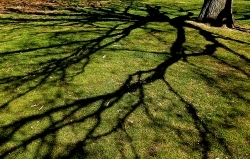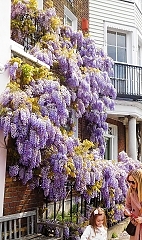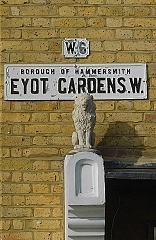Adam Yamey's Blog: YAMEY, page 127
May 3, 2022
Trees in Richmond
May 2, 2022
From his garden to his grave
IT IS PLEASANT to stroll beside the Thames along Chiswick Mall. Occasionally, we take a look at the graveyard of Chiswick’s St Nicholas Church. On a recent visit to this place, we walked deeper into it than usual and spotted a grave marked by a remarkable sculpture.
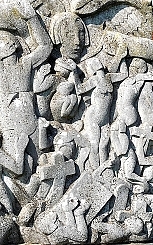
The idyllic, romantic, leafy churchyard by the river is chock full of graves. Several of them caught my attention. One is that for the artist William Hogarth, who lived close-by. His monument is protected by a cast-iron fence. An urn on a plinth decorated with an artist’s palette and brushes. It was erected after the death of his sister in 1781 (who is also commemorated on this monument) and was restored by a William Hogarth of Aberdeen in 1856. Another painter, Philippe Jacques de Loutherbourg (1740-1812), who was born in Strasbourg, is buried with his wife Lucy de Loutherborg (née Paget). Like Hogarth’s, their decaying monument on the north side of the cemetery is surrounded by cast iron railings. In 1789, Philippe gave up painting temporarily to develop his interest in alchemy and the supernatural. Later, he and his wife took up faith-healing. The remains of yet another painter, James Abbott McNeill Whistler (1834-1903), lie in the cemetery.
Private Frederick Hitch (1856-1913) is less famous than these artists. He was awarded the Victoria Cross for his brave actions during the Battle of Rorke’s Drift (January 1879) in the Anglo-Zulu War fought in South Africa. He is also buried in this large cemetery.
Amongst the more recent graves is the one with the unusual sculpture. It is that of Baronet Percy Harris (1876-1952), who was a Liberal politician. Son of a Polish immigrant, he was born in Kensington, and died there after a long career in parliamentary politics. According to a website listing British Jews in WW1, Percy was Jewish, yet his grave is distinctly Christian in sentiment. Aesthetically, his grave is the most remarkable one in the cemetery next to St Nicholas. It includes a semi-abstract, vorticist carving of The Resurrection of the Dead, created by the sculptor Edward Bainbridge Copnall (1903-1973) in the 1920s. Harris had acquired it for display in his garden long before it was moved to adorn his grave.
Although Percy Harris was born Jewish, he is buried in the graveyard of a Church of England parish church. Despite searching the Internet, including reading his extensive entry in the Dictionary of National Biography, I cannot determine whether or not he converted to Christianity sometime during his life.
May 1, 2022
Don’t even think about doing these things
AS A SPECIAL TREAT when I was a young child, I was allowed to feed the pigeons on Piazza Signoria in Florence (Italy), a city we visited annually during my childhood. My parents used to purchase paper cones filled with corn kernels for my sister and me. We used to put a few of these in the palms of our hands and allow the pigeons to perch on our fingertips whilst they fed on the corn. Looking back on this activity, which gave me great pleasure, I am surprised that my health and hygiene conscious mother allowed what the former Mayor of London, Ken Livingstone, called ‘rats with wings’ to risk sullying our hands and harming our health.
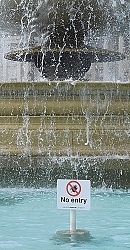
Oddly, when we were kids, we fed the pigeons in Florence but never fed their cousins that flocked around Trafalgar Square in London. Today, the 25th of April 2022, my wife and I walked across Trafalgar Square and observed that nowadays there are signs that indicate that feeding pigeons is forbidden. However, this activity, which I enjoyed as a child on holiday in Florence, is not the only thing forbidden in Trafalgar Square. The lovely fountains in the square now contain signs in the water, on which the words “No Entry” are written. Yet another activity in the square is no longer allowed. There are signs to deter visitors from climbing on the sculptures of the lions that lie at the base of Nelson’s Column. So, when you next visit Trafalgar Square with plans of feeding the pigeons, or bathing in the fountains (even to celebrate New Year), or straddling a lion, do not realise any of them: they are all outlawed.
April 29, 2022
Dusty no more: a town on the Thames
HENLEY-ON-THAMES is located at the Oxford end of a bridge across the River Thames, which separates the county of Oxfordshire from its neighbour Berkshire. Located on the old main road between London and Oxford, it retains much ‘olde-worlde’ charm. Its streets are lined with many buildings that were constructed in the 18th century and before. Some of these used to be coaching inns but are no longer. However, some of the hostelries that served wayfarers in times long ago are still serving thirsty and hungry customers today, for example: The Red Lion, where William III might have visited, now an upmarket restaurant; and The Catherine Wheel, now a branch of the Wetherspoons company. On a recent visit in April 2022, we enjoyed superb coffee at Pavilion on The Market Place, close to the Town Hall.
Beer lovers will not need reminding that Henley is the home of Brakspear & Sons, the brewery company. Founded in Henley in 1722, beer was brewed in the town since then, although some of the comapany’s products are now brewed elsewhere. Many of the brewery’s older buildings, now converted for new purposes, can be seen alongside New Street. The company’s offices are now located on Bull Courtyard off Bell Street.
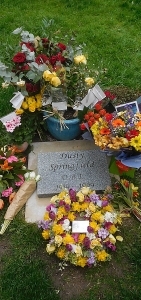
The stone bridge across the river was built in 1788. It is the finishing place of the annual Henley Royal Regatta held in summer, ever since its inception in 1839. Near the bridge, stands Henley’s parish church of St Mary the Virgin, which has a 16th century tower. The exterior walls of the southeast corner of the church is an eye-catching chequerboard of alternating masonry and flint squares. The church’s interior has been much modified by the Victorians. The churchyard north of the church is surrounded mainly by almshouses. Immediately next to the north side of the church stands a two-storied, half-timbered building, the Chantry House, some of whose beams come from trees felled in 1461 (according to scientific dating methods). Between 1552 and 1778, this edifice housed a school. Since 1923, it has housed the Parish Rooms.
The churchyard is filled with many gravestones. One of them immediately attracts the visitor as it is surrounded by generous amounts of fresh flowers. It is a memorial to the singer Dusty Springfield (1939-1999), who died in Henley. In the 1990s, Dusty lived by the Thames at Hurley near Henley. While in the area, she suffered from several bouts of breast cancer, the cause of her demise. Her funeral at St Mary’s in Henley was attended by many of her fans and leading lights in the British popular music scene including Elvis Costello, Lulu and the Pet Shop Boys. According to her wishes, Dusty was cremated, and some of her ashes were scattered in Henley and the rest in Ireland.
Dusty was not the only music celebrity to have lived in Henley. A man we met outside his house in the town reminded us that the Beatle George Harrison (1943-2001) had also lived in the town. He also mentioned that Henley’s former MP, the present Prime Minister Boris Johnson, had attended meetings in his home, and that he could tell us a thing or two … but he did not!
A colourful creeper
April 28, 2022
Remembering a generous lady in Westminster Abbey
CALL ME UNINFORMED but until the afternoon of the 22nd of April 2022 when I attended a service in Westminster Abbey, I had thought that Sidney Sussex College in Cambridge was named after someone called Sidney Sussex. Now, I know better.
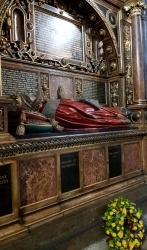
On the 22nd, we attended choral Evensong in Westminster Abbey. The choir was that of Sidney Sussex College, and they sung well despite the not too brilliant acoustics in the huge church. After the service, a select group of us, consisting mainly of people associated with the College, moved over to a small side chapel behind and north of the High Altar: The Chapel of St Paul. When we were all crowded into the small chapel, already filled with funerary monuments, the choir of Sidney Sussex squeezed in. They sung a short mass, and then the Master of the College laid a floral wreath at the foot of the monument to Frances Sidney, Countess of Sussex (c1531-1589). This ceremony, commemorating the founding of Sidney Sussex College, has been performed annually since her death.
Frances Sidney, aunt of the poet Phillip Sidney (1554-1587), was a philanthropist. She had inherited a great deal of money when her husband Thomas Radcliffe, Lord Fitzwalter, Lord Deputy of Ireland and from1557 the 3rd Earl of Sussex, died in 1583. One of her many good deeds is recorded on her colourful stone monument in Westminster Abbey. As per tradition, the Master of Sidney Sussex read out aloud the resumé of Frances’s life as recorded on the monument. The part that is pertinent to the college is as follows:
“…By her last will and testament she instituted a divinitie lectur to be redd in this Collegiate Church and by the same her testament gave also fyve thowsande powndes towards the buildinge of a newe colledge in the Universitie of Cambridge, with sufficient yerelie revenew for the continuall maintenaunce of one Maister, X Fellowes, and XX Schollers, eyther in ye same Colledge or ells in another house in ye said Universitie already builded, comenlie [commonly] called Clare Hall…”
To put it in plainer English, on her death in 1589, she bequeathed £5,000 (worth far more than £ 1 million today) to pay for the building of a new college in the University of Cambridge and to provide an annual revenue sufficient to finance 1 Master, 10 Fellows (i.e., academic teachers) and 20 scholars. The first sentence of the quote states that a “divine lectur” (i.e., prayers) should be said annually in the Abbey. And this is what was being done as we stood assembled in the small chapel. It was a curiously moving occasion especially when the wreath was laid at her monument. Later, one of the clerics who had been present at the ceremony explained to me that not only had Frances Sidney paid for the college, which is named in her memory but also she would have had to pay for the elaborate marble and alabaster monument erected to remember her.
As for the name of the college, Sidney Sussex, this is a shortened version of its full name: The College of the Lady Frances Sidney Sussex.
April 27, 2022
Eight bells and a bridge
BELIEVE IT OR NOT, busy Fulham in west London was a small country village in the early 19th century. Today, what was once the heart of the village, is the site of two bridges spanning the Thames. One carries the District Line railway tracks and pedestrians, and the other, an elegant stone bridge with five arches carries a road across the river. Known as Putney Bridge, the latter was completed in 1886 and designed by the prolific civil engineer Joseph Bazalgette.
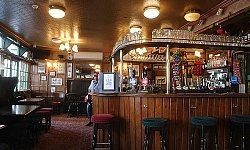 Inside The Eight Bells in Fulham
Inside The Eight Bells in FulhamPrior to the construction of the stone bridge, there was an earlier wooden bridge, known as ‘Fulham Bridge’. With roofed gatehouses at both ends and 26 arches (or openings), it was designed by Sir Jacob Acworth and completed in 1729. Its approach road was Fulham High Street. The bridge has long-since been demolished but a blind-ended, short inlet of the river, now named Swan Drawdock Nature Reserve runs right next to where the old bridge would have once begun.
The Eight Bells pub, which still serves customers, stands on Fulham High Street. Now housed in a Victorian building, it might have been first established as early as the 17th century. When the old bridge stood, it would have attracted much business from folk using the wooden crossing. Things changed when the new, current, bridge was constructed.
The approach to the new crossing, Putney Bridge, was not via Fulham High Street but by way of a new road, the present Putney Bridge Approach (the A 219), which does not pass the front of the Eight Bells. This led to a considerable loss of business for the pub, whose owners received £1000 in compensation: a great deal of money in the late 1880s.
The Eight Bells and its neighbour, a wonderful second-hand book shop, along with a few other shops near Putney Bridge station, although definitely not rural in appearance, retain a ‘villagey’ feel.
April 26, 2022
A slave trade abolitionist in Fulham
LESS FAMOUS THAN William Wilberforce (1759-1833), but equally important in helping to end Britain’s involvement in the slave trade, was Granville Sharp (1735-1813). Born in Durham, Sharp was apprenticed to a linen draper in London at the age of 15. A scholar at heart, he left his apprenticeship to become Clerk in the Ordnance Office at the Tower of London, a job that gave him more time to pursue his scholarly studies and music. One of his brothers, William Sharp (1729-1810), was a physician, who is believed to have treated King George III.
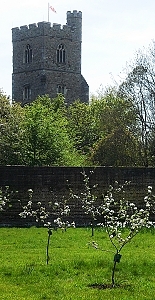 All Saints church in Fulham
All Saints church in FulhamOne of William’s patients was Jonathon Strong (c1747-1773), a black slave from the West Indies, who had been badly beaten-up by his master, a lawyer called David Lisle. William and Granville helped tend to Strong’s injuries and paid for him to spend four months in St Bartholomew’s Hospital. Lisle instigated a number of court cases to protect his ‘possession’ of Strong. Granville was deeply involved with making sure he lost them and that Strong became a freed man. The Strong case was the beginning of his keen and active involvement in the movement to abolish slavery. His involvement with this and subsequent legal cases connected with the unjustness of the slave trade gave him the reputation of being a “protector of the Negro”.
In 1787, Granville became one of the founder members of the Society for Effecting the Abolition of the Slave Trade. Though sometimes overshadowed today by other abolitionists such as Wilberforce and Thomas Clarkson (1760-1846) played a major role in hastening the end of the slave trade and slavery in places ruled by the British.
By the 1780s, there were approximately 15,000 ‘black’ people in Britain, many of them without employment. Ideas began to circulate that it would be a good idea to form a settlement in Africa to which the Africans could ‘return home’ and live as free individuals. One place that was suggested was Sierra Leone. Granville Sharp was consulted on this and felt that it would be an ideal location to set up a model community for the ‘blacks’. He suggested calling it ‘The Province of Freedom’. Sadly, the well-intentioned province that included a settlement called Granville Town was a failure.
Granville lived long enough to learn that the Act of Abolition received Royal Assent in 1807, but not long enough to know about the final abolition of the slave trade in the British Empire (in 1833). Granville’s brother William had a country dwelling, Fulham House, in Fulham. It was here that the ageing Granville moved after William died. He lived there with William’s widow, Catherine, and her family. It was in this house that Granville breathed his last.
Probably Fulham’s greatest resident, Granville Sharp was buried in the cemetery of Fulham’s parish church (All Saints). His funerary monument, which stands close to the boundary fence of Fulham Palace commemorates him, his brother William, and his sister Elizabeth Prowse. William’s wife Catharine (née Barwick) is also buried beneath this stone, which was restored in 2007.
April 25, 2022
Roman recycling
TOLLESBURY IN ESSEX on the Blackwater River estuary is a village just over 5 miles southeast of Tiptree, a small town close to the Wilkinson jam factory and museum. This charming village, where a good friend of ours lives, has a venerable parish church, St Mary the Virgin.
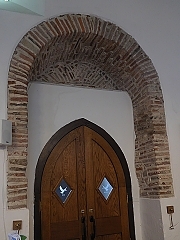 Roman bricks used to construct the arch above the south entrance of St Mary’s in Tollesbury, Essex.
Roman bricks used to construct the arch above the south entrance of St Mary’s in Tollesbury, Essex.In common with most of the parish churches we have visited during our extensive roamings around the English countryside, this church, whose construction had begun by the 11th century, contains a rich selection of interesting features. These are well described in a copiously illustrated booklet about the edifice published by the Friends of St Mary’s Tollesbury in early 2020. Amongst the interesting things we saw within St Mary’s, one of them particularly intrigued me: the incorporation of Roman bricks in the fabric of the church.
Archaeologists have uncovered the remains of a Romano-British cemetery near the village. They have concluded from their findings that in about 200 AD, there was a significant rural settlement located near Tollesbury at that time. Other remains are evidence that the district around the estuarine village has been the site of human activity since the Neolithic era (4000-2000 BC).
As if to prove that recycling is not simply a recent trend, the church of St Mary incorporates bricks made whilst the Romans occupied England. These can be seen clearly above the south doorway within the church. The 11th century arch above this portal is made entirely of recycled Roman bricks. Some more brickwork made with Roman bricks can be seen exposed above the gothic archway in the western wall of the nave, which is also part of the late 11th century bell tower.
Although the re-used Roman bricks have been ‘highlighted’ in St Mary’s, the structure of the parish church in the nearby village of Goldhanger also contains recycled Roman bricks. Making bricks at the time when these churches were built would have been far more laborious than making bricks using today’s industrial techniques. So, re-using bricks that had already been made would have been very sensible.

